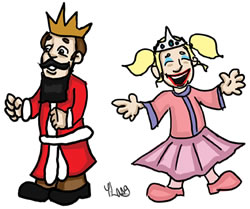Purim in 2011 will start on Sunday, the 20th of March and will continue for 2 days until Monday, the 21st of March.
On Jewish calendar, on year 5771, start on 14th of the Hebrew month of Adar II and continues until the night 15th of Adar II.
Note that in the Jewish calander, a holiday begins on the on the sunset of the previous day, so observing the Jews begin celebrate the Purim on the sunset of Saturday, the 19th of March.
*The month that was reversed from grief to joy. Esther 9:22
*When the month of Adar enters, we increase in joy. Talmud, Taanit 26b
There are many joyous dates on the Jewish calendar, but besides Purim, none of them affect the entire month, causing it to be auspicious and joyous. What is the intrinsic connection between Purim and Adar? Perhaps a comprehension of the unique nature of Purim will allow us to understand why its joy extends throughout the entire month of Adar.
The Hebrew Month of Adar is synonymous with joy because Adar has traditionally been a month of hope and good luck for the Jewish people. Adar is the last of the months on the Jewish calendar, and in this way represents completion.
The sages say that Adar is the best month to try to remove your personal barriers to holiness. And by removing those barriers, you creates the potential for the greatest joy.
The 'Mitzvot' of Purim (The main 'precepts' of Purim)
1) Listen to the Megillah (Scroll of Esther)
2) Give to the Needy (Matanot La’evyonim)
3) Send Food Portions to Friends (Mishloach Manot
4) Eat, Drink and Be Merry
-
Special Prayers (Al Hanissim, Torah reading). On Purim we include the Al HaNissim prayer, which describes the Purim miracle, in the evening, morning and afternoon prayers, as well as in the Grace After Meals. In the morning service there is a special reading from the Torah scroll in the synagogue (Exodus 17:8–16).
- Purim Customs: Masquerades and Hamantashen
A time-honored Purim custom is for children to dress up and disguise themselves—an allusion to the fact that the miracle of Purim was disguised in natural garments. This is also the significance behind a traditional Purim food, the hamantash—a pastry whose filling is hidden within a three-cornered crust.
They also say that prophecy can only come to someone who is happy. Jeremiah, Samuel, King David and others were not moping around in a bad mood when they received prophecy. The tradition says that some of the prophets even used music to help put them in an elevated mood in order to experience prophecy.
True happiness is not achieved by satisfying our physical desires, as the body would have us thinking. Just as the prophet uses music to lighten his mood in order to access the spiritual world, true happiness comes through using the pleasures of this world to elevate our consciousness in order to bind our thoughts to spirituality.
Adar is characterized by joy because it is the month of transforming dread into joy. Adar was the month that Haman selected for grief and mourning to us, but for the past 2,400 years has instead been a time of rejoicing and celebration. It's when we see G-d's hand in our lifes -- and realize how we gives our potential to defeat our enemies, then we have discovered the source of life's greatest joy. This Adar, may we be inspired to conquer enemies -- whether they come from afar, or from deep inside ourselves. That is the great opportunity of this month.
It can actually be argued that, in a certain sense, our perpetual relationship with G-d is more evident when we are exiled and downtrodden due to our sins, and G-d still interferes on our behalf, as was demonstrated by the Purim miracle. This phenomenon demonstrates the durability of our relationship; the ability of our essential identity to survive no matter our external state.
All other holidays celebrate the 'highs' of our nation. And therefore their joy is limited, because highs don't last.
Purim celebrates a time when we were at a low point in our history – but our relationship with G-d remained intact. Its joy is therefore greater than the joy of any other holiday, because it demonstrates the essential nature of our relationship with G-d -- and that is a constant.




























